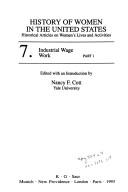| Listing 1 - 4 of 4 |
Sort by
|
Book
Year: 2013 Publisher: Cambridge, Mass. National Bureau of Economic Research
Abstract | Keywords | Export | Availability | Bookmark
 Loading...
Loading...Choose an application
- Reference Manager
- EndNote
- RefWorks (Direct export to RefWorks)
Digital
Year: 2013 Publisher: Cambridge, Mass. National Bureau of Economic Research
Abstract | Keywords | Export | Availability | Bookmark
 Loading...
Loading...Choose an application
- Reference Manager
- EndNote
- RefWorks (Direct export to RefWorks)
The most prominent feature of the female labor force across the past hundred years is its enormous growth. But many believe that the increase was discontinuous. Our purpose is to identify the short- and long-run impacts of WWII on the labor supply of women who were currently married in 1950 and 1960. We use mobilization rates for various groups of men (by age, race, fatherhood) to see whether there was a wartime impact. We find that an aggregate mobilization rate produces the largest and most robust impacts on both weeks worked and the labor force participation of married white (non-farm) women. The impact, moreover, was experienced primarily by women in the top half of the education distribution. Women who were married but without children during WWII were the group most impacted by the mobilization rate in 1950, although by 1960 WWII still influenced the labor supply decisions of them as well as those with children during WWII. We end the paper with a resolution between the watershed and revisionist views of the role of WWII on female labor supply.
Book
Year: 2013 Publisher: Cambridge, Mass. National Bureau of Economic Research
Abstract | Keywords | Export | Availability | Bookmark
 Loading...
Loading...Choose an application
- Reference Manager
- EndNote
- RefWorks (Direct export to RefWorks)
The most prominent feature of the female labor force across the past hundred years is its enormous growth. But many believe that the increase was discontinuous. Our purpose is to identify the short- and long-run impacts of WWII on the labor supply of women who were currently married in 1950 and 1960. We use mobilization rates for various groups of men (by age, race, fatherhood) to see whether there was a wartime impact. We find that an aggregate mobilization rate produces the largest and most robust impacts on both weeks worked and the labor force participation of married white (non-farm) women. The impact, moreover, was experienced primarily by women in the top half of the education distribution. Women who were married but without children during WWII were the group most impacted by the mobilization rate in 1950, although by 1960 WWII still influenced the labor supply decisions of them as well as those with children during WWII. We end the paper with a resolution between the watershed and revisionist views of the role of WWII on female labor supply.


ISBN: 9783110969450 9783598414619 Year: 2013 Publisher: Berlin ;; Boston K. G. Saur
Abstract | Keywords | Export | Availability | Bookmark
 Loading...
Loading...Choose an application
- Reference Manager
- EndNote
- RefWorks (Direct export to RefWorks)
| Listing 1 - 4 of 4 |
Sort by
|

 Search
Search Feedback
Feedback About UniCat
About UniCat  Help
Help News
News